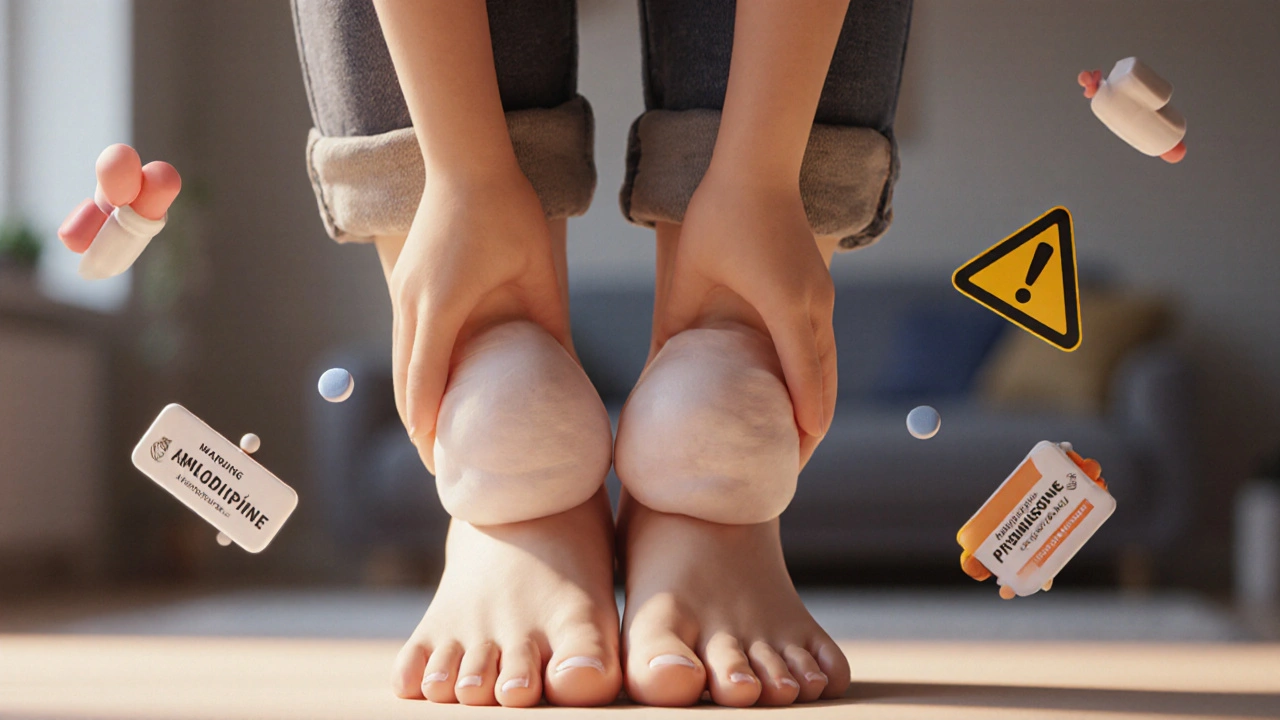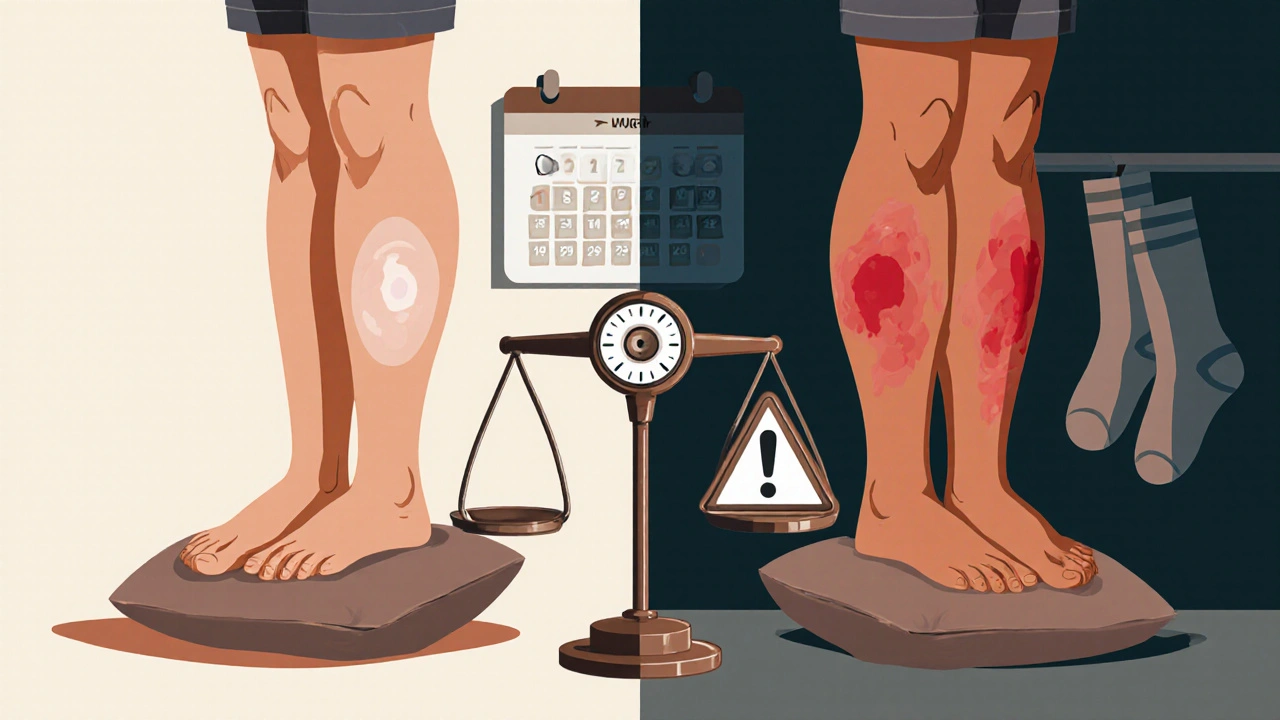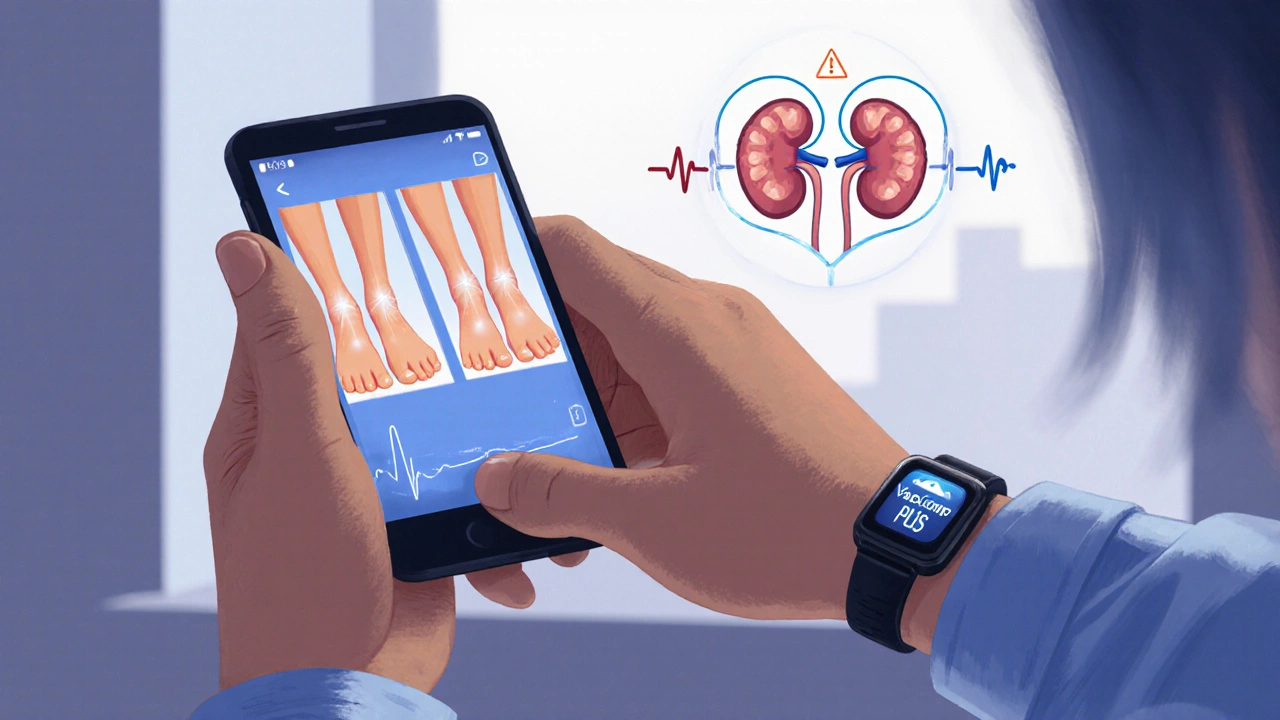Medication-Related Swelling and Edema: When to Worry

Swelling in your ankles, feet, or hands after starting a new medication isn’t always harmless. It’s common-but that doesn’t mean you should ignore it. Millions of people experience this every year, and most assume it’s just a side effect they’ll get used to. But sometimes, that puffiness is a red flag. The difference between a mild annoyance and a medical emergency can come down to a few simple signs you can watch for at home.
What Exactly Is Medication-Related Edema?
Edema is just a fancy word for swelling caused by fluid leaking out of tiny blood vessels and building up in your tissues. It’s most noticeable in the legs, ankles, and feet-called pedal edema-but can also show up in your hands, face, or even lungs. About 75% of all edema cases happen in the lower limbs, according to the American Academy of Family Physicians.
It’s not a disease itself. It’s a reaction. And many medications trigger it. Calcium channel blockers like amlodipine cause swelling in 10-20% of users. Gabapentin and pregabalin, often prescribed for nerve pain, do it in 6-8% of people. Even common drugs like ibuprofen or prednisone can make you retain fluid. Hormonal pills-birth control or hormone replacement therapy-also carry a risk, especially at higher doses.
Here’s the thing: most of the time, this swelling is mild. Your ankles might look puffy in the evening, but they’re fine in the morning. You might gain a pound or two. But if you don’t know what to look for, you could miss the warning signs that something more serious is going on.
Which Medications Are Most Likely to Cause Swelling?
Not all meds cause edema the same way. Some are more predictable than others. Here’s a breakdown of the biggest culprits, backed by clinical data:
- Calcium channel blockers (amlodipine, nifedipine): 10-20% of users develop ankle swelling. At 10mg daily, up to 25% of people see noticeable puffiness.
- Gabapentin and pregabalin: 6-8% risk. Patients often report swelling after a few weeks on the drug, even if they’ve taken it before without issues.
- Thiazolidinediones (pioglitazone, rosiglitazone): Used for type 2 diabetes, these can cause rapid fluid retention. Up to 10% of users gain weight and swell noticeably within weeks.
- Corticosteroids (prednisone): At doses above 20mg daily for more than two weeks, 20-30% of patients develop swelling. This isn’t just puffiness-it’s systemic fluid overload.
- NSAIDs (ibuprofen, naproxen): Even over-the-counter painkillers can cause mild edema in about 3% of regular users.
- Hormonal therapies: Birth control pills with 30-35mcg estrogen and estrogen replacement therapy can trigger swelling in 5-15% of users.
These aren’t rare side effects. They’re common enough that doctors should expect them. But here’s where things get dangerous: many patients are told, “It’s just a side effect,” and never get checked for deeper problems.
When Is Swelling a Sign of Something Dangerous?
Not all swelling is created equal. Medication-induced edema is usually symmetrical (both legs), soft to the touch, and improves with rest or elevation. But if your swelling looks different, it could signal a life-threatening condition.
Here’s how to tell the difference:
- Heart failure: Swelling that gets worse as the day goes on, especially if you’re also short of breath when lying flat (orthopnea) or waking up gasping for air (paroxysmal nocturnal dyspnea). You might notice your neck veins bulging or feel fatigued all the time.
- Kidney disease: Massive swelling in both legs and around the eyes, especially in the morning. Often accompanied by foamy urine (protein loss) and unexplained weight gain.
- Liver cirrhosis: Swelling in the abdomen (ascites) along with leg swelling. Skin may look yellowed, and you might feel bloated or nauseated.
- Deep vein thrombosis (DVT): Swelling in just one leg, often with pain, warmth, or redness. If you measure both calves and one is 2cm or more larger, this is urgent.
- Lymphedema: Swelling that doesn’t go down overnight, feels firm or hard, and gets worse over time. Common after cancer surgery or radiation.
Dr. Mark A. Danchenko, a cardiologist at Johns Hopkins, says: “Any new bilateral swelling in someone on amlodipine should make you ask: Is this the drug-or is it heart failure?”
One Reddit user shared how their doctor dismissed their pioglitazone-related swelling until they developed pulmonary edema and ended up in the hospital. That’s not rare. The FDA has logged over 12,000 edema-related adverse events in just 18 months. Many of those cases were preventable.

What Should You Do If You Notice Swelling?
If you’ve started a new medication and your ankles are puffy, don’t panic-but don’t wait either. Here’s what to do next:
- Track your weight daily. A gain of 2.2 pounds (1 kg) in 24 hours means you’re retaining fluid. Write it down.
- Elevate your legs. Do it for 15-20 minutes, four times a day. You’ll see a 1.5cm reduction in ankle swelling within two days.
- Try compression socks. 20-30 mmHg pressure socks reduce swelling volume by 30% in a week. They’re not magic, but they help.
- Lower your sodium. Cut salt intake to under 2,000mg per day. Most people eat 3,400mg. That extra 1,400mg is likely making your swelling worse.
- Take photos. Snap a picture of your ankles every morning. Compare them over time. It’s easier to spot changes than to remember how things looked.
These steps won’t fix the root cause-but they’ll help you monitor whether things are getting better or worse.
When to Call Your Doctor Immediately
Not every puffiness needs an ER trip. But these signs mean you should call your doctor today:
- Swelling in just one leg, especially with pain or redness (possible DVT)
- Sudden shortness of breath, chest tightness, or coughing up frothy mucus (signs of fluid in the lungs)
- Weight gain of more than 5% in one month (e.g., 10 pounds on a 200-pound person)
- Swelling that doesn’t improve after stopping the suspected drug for 2 weeks
- Swelling along with confusion, dizziness, or reduced urination
The American College of Physicians recommends that anyone on prednisone above 20mg for more than two weeks should be checked monthly for edema, weight, and blood pressure. That’s not optional-it’s standard care.
What Happens Next? Treatment Options
If your doctor confirms the swelling is from medication, they have a few paths:
- Switch the drug. For example, if amlodipine is causing swelling, switching to losartan (an ARB) often resolves it without losing blood pressure control. One Reddit user reported their swelling vanished in two weeks after switching.
- Reduce the dose. Lowering amlodipine from 10mg to 5mg cuts edema risk from 25% to 15%.
- Add a diuretic. Sometimes doctors prescribe a low-dose water pill. But this isn’t always the answer-it treats the symptom, not the cause.
- Stop the drug. For drugs like pioglitazone, stopping is often the safest move. The American Diabetes Association says fluid retention from these drugs can worsen heart failure.
There’s also new tech helping. In March 2023, the FDA approved the first wearable device, VascuComp Plus, that uses bioimpedance to detect fluid buildup before it’s visible. It’s still rare in clinics, but it’s a sign of where things are headed.

Why This Matters More Than You Think
Medication-induced edema isn’t just a nuisance. It’s a hidden burden on the healthcare system. In the U.S., it leads to over 5 million doctor visits every year and costs $4.8 billion annually. Many of those visits could be avoided.
Older adults are especially at risk. The American Geriatrics Society lists amlodipine, gabapentin, and pioglitazone as “potentially inappropriate” for people over 75 because of high swelling risk. One in four adults over 65 takes at least one drug that causes edema. That’s not just bad luck-it’s a systemic issue.
Some hospitals, like Mayo Clinic, have cut severe edema cases by 22% just by adding alerts to electronic health records when high-risk drugs are prescribed together. That’s a simple fix that saves lives.
And yet, most patients aren’t warned. They’re handed a prescription and told to take it. No one says, “Watch for swelling. If it gets worse, call us.”
You’re Not Overreacting
If you’ve noticed swelling after starting a new pill, you’re not being dramatic. You’re paying attention-and that’s exactly what you should be doing. Medications save lives. But they can also hide danger in plain sight.
Swelling is your body’s way of saying, “Something’s off.” Don’t let a doctor’s dismissal make you ignore it. Keep track. Know the red flags. Ask the right questions.
Because sometimes, the difference between a mild side effect and a medical emergency is just one conversation you had-or didn’t have.
Can over-the-counter painkillers like ibuprofen cause swelling?
Yes. Regular use of NSAIDs like ibuprofen or naproxen can cause mild fluid retention in about 3% of users. This is more likely if you’re over 60, have kidney issues, or take them for long periods. It’s usually not severe, but if you notice your ankles puffing up after starting these meds, it’s worth mentioning to your doctor.
Will drinking more water help reduce medication-related swelling?
No. Drinking more water won’t fix swelling caused by medications. In fact, it can make it worse. The issue isn’t dehydration-it’s fluid leaking out of blood vessels due to how the drug affects your body’s chemistry. Focus on lowering sodium, elevating your legs, and wearing compression socks instead.
How long does it take for swelling to go away after stopping the medication?
It varies. For drugs like amlodipine or gabapentin, swelling often starts to improve within 1-2 weeks after stopping. For corticosteroids or pioglitazone, it can take 3-6 weeks because the body needs time to flush out the excess fluid. If swelling doesn’t improve after 4 weeks, you need further evaluation for other causes like heart or kidney problems.
Can compression socks help with swelling from pills?
Yes. Compression socks with 20-30 mmHg pressure can reduce swelling volume by up to 30% in just 7 days. They don’t fix the root cause, but they help manage symptoms and prevent skin damage from prolonged swelling. They’re especially useful if you’re waiting to switch medications or if your doctor advises keeping the current one.
Is swelling in only one leg always a blood clot?
Not always, but it’s a major red flag. Swelling in just one leg-especially if it’s painful, warm, or red-could be deep vein thrombosis (DVT), which can lead to a life-threatening pulmonary embolism. Even if you’re on a medication that causes swelling elsewhere, unilateral swelling needs immediate medical attention. Don’t wait. Get checked.
Should I stop my medication if I notice swelling?
No-don’t stop any medication without talking to your doctor first. Some drugs, like blood pressure or seizure meds, can be dangerous to stop suddenly. Instead, document your symptoms, track your weight, and schedule a visit. Your doctor can decide whether to adjust the dose, switch the drug, or run tests to rule out other causes.
What to Do Next
If you’re on any of the high-risk medications listed here and you’ve noticed swelling, start tracking now. Weigh yourself every morning. Take photos of your ankles. Note when the swelling is worst. Write down how you feel-any shortness of breath, fatigue, or chest tightness.
Then, bring that info to your next appointment. Don’t just say, “My ankles are swollen.” Say, “I’ve gained 4 pounds in 10 days, my ankles are puffy after standing, and I’m more tired than usual. I’m on amlodipine. What should we check?”
That kind of detail changes everything. It turns a vague complaint into a clear signal-and that’s how you get the right answer before it becomes a crisis.

Eric Donald
October 31, 2025 AT 16:04Appreciate the detailed breakdown. I’ve been on amlodipine for 3 years and noticed my ankles swelling last winter. Thought it was just aging until I read this. Started tracking weight and switched to losartan-swelling dropped 80% in 10 days. Doctors don’t always connect the dots, but tracking data makes it impossible to ignore.
Also, compression socks are a game-changer. No magic cure, but they let me walk without feeling like I’m carrying water balloons.
Brenda Flores
November 2, 2025 AT 01:47Thank you for this incredibly thorough and compassionate resource. I am so grateful for the clarity you’ve provided regarding medication-induced edema-it is far too often dismissed as trivial, when in reality, it can be a critical indicator of systemic dysfunction.
I’ve witnessed elderly relatives suffer silently, told to ‘just elevate their legs’ without further investigation. Your emphasis on documentation, weight tracking, and proactive communication with providers is not only medically sound-it is ethically necessary. Please continue sharing knowledge like this. The healthcare system needs more voices like yours.
Josh Arce
November 2, 2025 AT 19:00LMAO so now we’re blaming drugs for everything? My cousin’s ankles swell because he eats tacos and sits on his butt all day. You wanna blame amlodipine? Fine. But don’t act like every puffy ankle is a heart attack waiting to happen.
Also, ‘bioimpedance wearable’? Bro, that’s a fancy scale with Bluetooth. Stop hyping tech like it’s the second coming.
And yes, ibuprofen causes swelling. So does crying too much. Does that mean we stop crying? No. We stop being drama queens.
Eli Grinvald
November 3, 2025 AT 12:19THIS. 😭 I’ve been on gabapentin for 8 months and thought the puffiness was just ‘me being lazy.’ Took photos every morning like you said-holy crap, my ankles looked like balloons by week 6. Told my doc and she switched me to pregabalin at half dose. Swelling’s down 70%.
Also, compression socks are my new bestie. I wear them with sandals now. No shame. 🧦💙
Alexis Hernandez
November 4, 2025 AT 17:08Man, this is the kind of post that makes you feel like you’re not crazy for noticing stuff.
I’m 68, on a low-dose steroid for asthma, and my legs started looking like overstuffed sausages. My doc said ‘it’s the meds, no big deal.’ But I kept track-gained 6 lbs in 3 weeks, couldn’t fit into my shoes. Turned out it wasn’t just the steroid-it was hiding early heart stuff. They caught it because I had the numbers.
Don’t let anyone tell you swelling is ‘normal.’ Your body’s not asking for a medal, it’s asking for help. Write it down. Take the pic. Say something. You’re not overreacting-you’re the one who’s awake.
brajagopal debbarma
November 5, 2025 AT 01:27Wow. So now every Indian grandma with swollen legs has to blame her blood pressure pill? In my village, swelling means you drank too much chai and sat too long. Not a hospital visit. Not a bioimpedance thing. Just life.
Also, 12,000 adverse events? That’s 0.0001% of users. You’re scared of a pill that saves your life? Maybe stop taking pills and go meditate instead.
Carly Smith
November 5, 2025 AT 16:56Why are people so obsessed with swelling? Just wear bigger shoes. Or don’t stand. Or don’t take meds. Or die. Whatever.
I’ve been on prednisone for 5 years and my face looks like a balloon but I’m alive so who cares. You’re all just anxious millennials who think every ache is cancer. Chill. Drink water. Eat less salt. Stop Googling.
Also compression socks? So 2018. Try leggings. Same effect. Less money.
Kurt Stallings
November 7, 2025 AT 13:46Overstated. Anecdotal. Emotionally manipulative. The data is cherry-picked. You’re conflating correlation with causation and weaponizing patient anxiety to sell a narrative.
Edema is a physiological response. Not a crisis. Most people on amlodipine don’t develop heart failure. The FDA stats include self-reported cases. Many are placebo effects.
And you want us to trust a Reddit user who ‘swelling vanished in two weeks’? That’s not medicine. That’s TikTok.
Stop fearmongering. Trust your doctor. Or don’t take the pill. But don’t turn a common side effect into a moral panic.